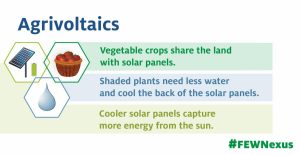Agrivoltaics and Shared Light

The Food Energy Water Nexus
Agrivoltaics, also known as agrophotovoltaics (APV) is the process of co-developing the same area of land for both solar power and agriculture. The technique was originally conceived by Adolf Goetzberger and Armin Zastrow in 1981. They came up with the idea of sharing light between two types of production. Agrivoltaics has been implemented in Japan since 2004. The practice has expanded into Asia and Europe. Several crops can benefit, including fruit production.
The dual use of arable land is based on the “light saturation point” for food production. This is a point at which additional light will not result in additional photosynthesis and thus additional crop production. More than 1,000 open field power plants have been developed in Japan. There, agrivoltaics is based on 30% shading of crops by solar arrays; some systems have been built with 50% shading.
A feature of agrivoltaics is that “demountable” structures have been developed so that farmers can move solar arrays based on crop rotations and farming needs. Japanese farmers cultivate ginseng, ashitaba, and coriander. In China, Panda Green Energy installed panels over a vineyard. In the United States, U.C. Davis researchers are conducting agrivoltaic experiments with crops including alfalfa, sorghum, lettuce, spinach, beets, carrots, chard, radishes, potatoes, arugula, mint, turnips, kale, parsley, coriander, beans, peas, shallots, and mustard.
